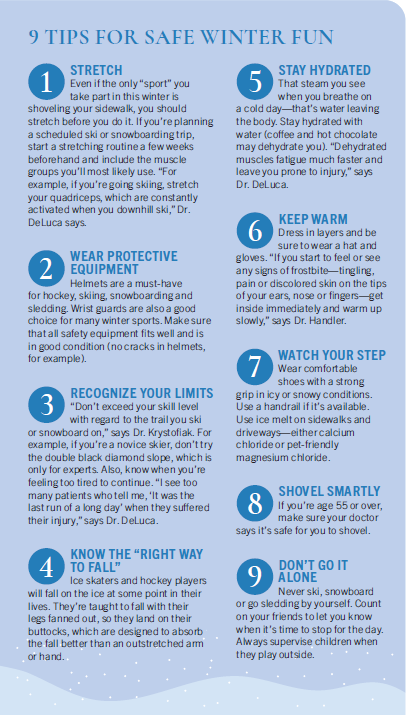
Snowy days bring out the kid in all of us. But whether you ski, sled, skate or snowboard, those slippery slopes and slick surfaces can also increase your risk for mishaps.
Nearly 200,000 winter sports injuries occur each year, according to the U.S. Consumer Products Safety Commission. Add in the 1 million slips, trips and falls that occur every winter, and your risks of suffering an accident that needs medical care increase significantly.
Here are some of the most common winter injuries—and advice from three top doctors on what to do if you sustain them.
CONCUSSION - A concussion is a traumatic brain injury that can occur if you fall and hit your head, which is all too common among people who sled, ski and snowboard. Symptoms range from mild (blurred vision, drowsiness, confusion or dizziness) to severe (serious headache, light or noise sensitivity, balance issues— even loss of consciousness). “If you experience vomiting, loss of consciousness, midline neck pain or numbness, slurred speech, tingling or weakness in any area of the body, or if you feel the worst headache of your life, go to an urgent care center or emergency department immediately,” says Jason Krystofiak, MD, a board-certified, fellowship-trained primary care sports medicine physician at Cooperman Barnabas Medical Center (CBMC) and a member of RWJBarnabas Health Medical Group. Even if your symptoms are mild, if they don’t go away on their own, consult your health care provider.
SHOULDER INJURIES - Dislocated shoulders are among the more common injuries suffered by skiers, ice skaters and hockey players. “When you fall, your instinct is to break your fall with an outstretched arm, which can cause the dislocation,” says Peter DeLuca, MD, Chief of Sports Medicine at CBMC. Falls on your arms and hands can also cause wrist sprains and fractures to your hand or wrist, all of which require medical attention.
KNEE INJURIES - These rank as the top winter sports injuries for skiers. They occur most often in one of the two ligaments (anterior cruciate ligament or medial collateral ligament) that support and stabilize the knee, but they can also include fractures of the kneecap or the bones above and below the knee. People suffering serious knee injuries may require surgery and will likely need physical therapy and rehabilitation.
SKIER’S THUMB - This is the second-most common wintertime injury among skiers. It happens when a skier falls and holds onto the pole. “The pole acts like a fulcrum against the thumb,” Dr. DeLuca says. “This can lead to a torn ligament that may require surgery to fix.”
SNOWBOARDER’S ANKLE - This is technically called a fracture of the talus bone, which is the bone located directly above your heel. “The way the foot is clipped into a snowboard puts snowboarders at particular risk,” Dr. DeLuca says.
OTHER COMMON WINTER INJURIES - Any slip or fall on the snow could lead to fractures or back and neck injuries. In addition, shoveling heavy amounts of snow (or any kind of strenuous exercise) may increase the risk of a heart attack. “If you feel chest pain or shortness of breath, call 911 immediately,” says Eric Handler, DO, Chair of Emergency Medicine at CBMC.
For more information about Orthopedic Services, visit our website or call 973-322-7005.
